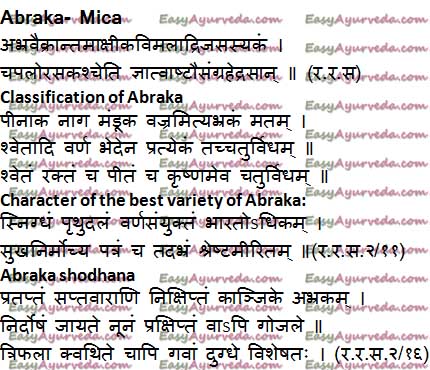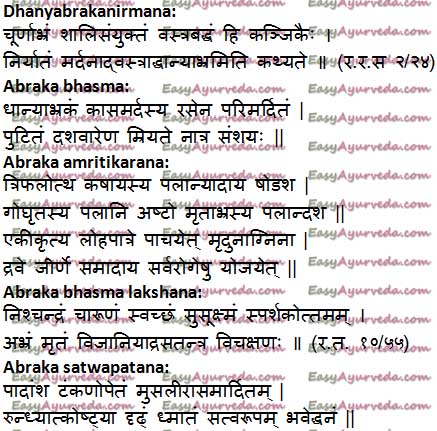Abhraka (Abraka) Shodhana, Marana, Satvapatana – Purification, Incineration
Abhraka is mentioned as the first substance in the classification of Maharasa according to Rasaratna Samucchaya. It is widely used for anti ageing purposes. This mineral is freely available in parts of state of Bihar, Tamilnadu, Karnataka and Rajasthan.
Table of Contents
Available ores
Abhrak is available in the forms of –
Muscovite- [H2KAl3 (SiO4)3]
Biotite – (H, K )2 (MgFe)2 (AlFe)2 (SiO4)3
Phlogophite – [HK (MgF)]3 Mg3 Al (SiO4)3
Lepidolite –KLi [Al (OHF)2 Al (SiO4)3
Paragonite- H2NaAl3 (SiO4)3
The above classification is based upon the chemical content present in the mineral.
Types
Classification of Abrak:
Based upon the color of Mica, it is classified into four types namely
Rakta (Red),
Peeta (Yellow),
Neela (Blue) and
Krishna (Black).
Among these four types, Krishna variety is the best.
Classical reference

According to structure, Mica is of 4 types.
1. Pinaka Abhraka: Upon subjecting it to fire, the layers get separated. Its use can cause severe constipation and death.
2. Naga Abhraka: On subjecting it to fire, it produces hissing type of sound similar to snake. Its therapeutic use leads to Mandala type of skin disorder.
3. Mandooka Abhraka: On subjecting to fire, the layers of abraka jump like frog and therapeutic use of this type of abraka causes Ashmari roga that cannot be cured even with surgery.
4. Vajra Abhraka: Upon subjecting it to fire, it will be free of Doshas. It is suitable for Deha siddhi and Loha siddhi. It is capable of curing all types of diseases.
Read – Abhrak Bhasma – Benefits, Dosage, Ingredients, Side Effects
The above characteristic feature is observed due to the presence of moisture or water content present in between the layers of mica which tries to escape during heating process and hence gives various characteristic features.
Hence there are total of 16 varieties of Mica i.e. each variety of Mica based on structure has 4 colored type. Out of these Krishna Vajra Abraka is considered as the best variety.
Synonyms
Few other names of abraka:
Abhraka, Gagana, Bhrunga, Abhra, Kha, Vyoma, Anantaka, Akasha, Ambara, Amala, Megha, Antariksha.
The above synonyms denote the meaning of Akasha i.e. sky or space.
Girija, Bahupatra, Vajra, Ghana.
These synonyms denote the hardness or nature of abraka.
Character of the best variety of Abraka:
The Abraka having the feel of unctuousness, thick layers which can be easily separated, having thick contrast of color and heavy in weight is considered as the best and should be used for further needs.
Abraka purification
Abraka shodhana
Before Abraka used for therapeutic use, it should be subjected to purification process (shodhana).
The Abraka layers should be taken and heated till red hot over fire source by holding them with tongs. Then it is immediately dipped in either cow’s urine, gruel (Kanji), decoction of triphala or milk.
If milk is used for purification process it is considered special or best. The process is repeated for 7 times. This procedure is called Nirvapa.
The purpose of shodhana for abraka is to remove any physical impurity like sand particles which may be collected when extracting from earth.
Read related: Concept Of Shodhana In Rasashastra
After the procedure of shodhana, the abraka becomes soft and brittle which is needed for the next procedure called ‘Dhanyabraka’ nirmana.
Dhanyabraka

Preparation
Dhanyabraka nirmana:
The powdered rough pieces of Abraka is further cut or powdered into small pieces as far as possible. Then the Abraka is taken in a jute bag which contains one fourth quantity of whole rice grain (along with husk) and tied into a bolus form (pottali). This bolus is dipped into a big vessel containing ‘kanji’ (gruel) and kept for 3 days.
After 3 days the bolus is loosened a bit and the jute bag is rubbed vigorously using foot. Care should be taken to protect foot. Again the bolus is dipped in kanji. After an hour, again the bolus is rubbed with foot.
The procedure is repeated a couple of times. Due to the sharp pointed part of the husk and rice grain, the Abraka is pierced and turns to smaller particle. Later the abaraka particles are filtered from the kanji.
In the textbook of Ananda Kanda, another method is explained for Dhanyabraka nirmana. Krishnabraka (black variety of abraka) is taken in an earthen pot and heated very well. Later the Abraka layer is dipped in arka juice (Calotropis gigantia), gruel, cows urine, triphala decoction for 3 times each.
The purpose of this procedure is to soften the Abraka, separate the layers and make it into small particle form so that it can be used for ‘Bhasmikarana’ (powder) form.
Abraka ash
Abraka bhasma:
Chakrika nirmana (preparing round, flat pieces) of Abraka is the initial procedure.
Dhanyabraka is taken in mortar and pestle and mixed with Kasamarda swarasa (juice of Cassia occidentalis) and trituration is done.
Once trituration is completed, abraka chakrika (flat pieces) are prepared and kept in sharava yantra (flat earthen plate) and subjected to ‘gaja puta’. (high quantum of heat).
After cooling, the abraka chakrika are removed and again triturated using Kasamarda swarasa.
The entire procedure is repeated for 10 times. After the 10th time, abraka bhasma is obtained after grinding the abraka chakrika in loha khalva yantra.
Similar methods for the preparation of Abraka bhasma have been mentioned in various texts related to Rasashastra, where the bhavana dravya has been changed.
These are-
• Dhanyabhraka is triturated with Musta swarasa (juice of Cyprus rotundus) to form cakes, which is given Gajaputa of heat. This process is repeated ten times, to get Abhraka Bhasma.
• Dhanyabhraka is triturated with Tanduliya swarasa / Apamarga (juice of Achyranthus aspera) and cakes are given 10 gajaputa of heat.
• Dhanyabhraka is mixed with equal part of jaggery and given Bhavana with Eranda patra swarasa (juice of castor leaves), cakes are prepared, wrapped in Vata patras (leaves of Banyan tree), and this is subjected to three Gajaputa.
To prepare good quality of Baraka bhasma which is used for therapeutic purpose, then abraka should be subjected to 10-100 gaja puta and for Rasayana benefit it is subjected for 100-1000 gaja puta.
Special procedures on abraka
Abraka amritikarana:
The process by which the abraka bhasma attains the property of amrita is called as ‘amritikarana’.
10 parts of Abraka bhasma, 16 parts of triphala kashaya and 8 parts of ghee is taken in a pan together and heated over medium fire till complete the water content is lost. Once the mixture is completely dry, the pan is closed and Abraka is subjected for high heat for some time. After the pan cools, black colored Abraka bhasma is obtained. Then the bhasma is subjected for trituration with decoction of Manjishta moola (Rubia cordifolia root). Later Abraka chakrika is prepared and subjected to gaja puta. The entire procedure is repeated for 4-5 times till the Abraka bhasma lose its shiny nature completely.
Abraka bhasma lakshana:
Properly prepared Abraka bhasma will not be having any luster or shining. It will be red in color, fine powder in nature and soft to touch.
Read related: Shilajit Uses, Tests For Quality, Purification
Abraka satwapatana:
Abhraka is mixed with 1/4th parts of Tankana (Borax), triturated with Musalee swarasa (juice of Chlorophytum borivilianum), bolus is made, subjected to intense fire in a crucible till the Abraka is in molten state. Later it is poured in an iron pan till it gets cooled. Later the Abraka is powdered and then using a magnet, Abhraka satwa is collected.
Special samskaras (processes) for abhraka:
Abraka is one mineral for which five samskaras namely Shodhana, Dhanyabraka, Marana, Satwapatana and Amritikarana is done. These processes give an indication about the various processes which are needed to obtain good quality of Abraka bhasma.
Ash contents
Content in abraka bhasma:
On analysis, abraka bhasma is found to contain Silica, Ferric oxide, Aluminia, Magnesia, Lime in various proportions.
Dose
Dosage:
The dosage of abraka bhasma when used alone is ½ to 1 ratti i.e. 65 mg to 125 mg along with anupana like milk, ghee, butter or suitable decoction according to the disease for which the treatment is given.
Medicinal properties
Qualities of abraka bhasma:
It has the following properties-
Balya – provide strength
Netravardaka – Improve vision
Buddivardaka – Improve intelligence
Stanyajanana – Promotes and improves breast milk in lactating women
Varnya – Improve complexion of skin
Keshya – Promotes scalp hair growth
Deepana, Ruchya – improve appetite and taste perception
Abraka bhasma is useful to treat fever, respiratory diseases, Low libido and degeneration of nerves.
Read more about Abhraka Bhasma
Popular formulations
Important ayurvedic medicines containing abraka:
Arogyavardini Rasa – widely used in skin diseases and liver disorders
Panchamrita vati
Yogendra Rasa
Vijaya parpati
Gagana parpati
Agnikumara Rasa – used in digestive disorders
Vasant Kusumakara Rasa– used in the treatment of urinary tract disorders, diabetes
Swasakasa Chintamani Rasa – used in asthma, chronic respiratory disorders.
Studies conducted
Research articles related to Abhraka:
Significance of mica in ayurvedic products: an overview- Mica after repeated burning is turned into bhasma which is used against many diseases including respiratory tract infections, hepatic diseases etc.
Study on the general properties of abraka bhasma: a nano medicine- Abhrak bhasma is a type of ayurvedic preparation prepared from repeated incineration of mica mineral with decoction of various medicinal herbs. In the current study, an attempt has been made to analyze the chemical modifications that abhrak bhasma possibly goes through in the GI tract. Additionally the antibacterial and antifungal properties of abhrak bhasma were also studied.
Effect of abraka bhasma on the physiology: The effect of abhrak bhasma on Drosophila was studied. Longevity, body weight, heat tolerance and behavioural modifications were kept as parameters.
Preparation and evaluation of abraka bhasma: An analytical study on abhraka basma was conducted using modern parameters like LOD, LOI, Estimation of Iron, Aluminium, Magnesium, silica, XRD and SEM analysis.
Herbo- metallic indian nano medicine: A literary review was conducted on abraka bhasma
Author:
Dr.BK Prashanth M.D (Ayu), Ph.D
E mail: [email protected]
Click to consult Dr. Prashanth B.K









